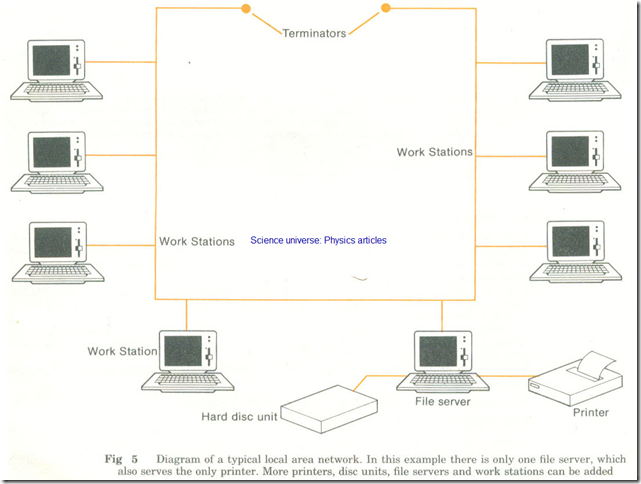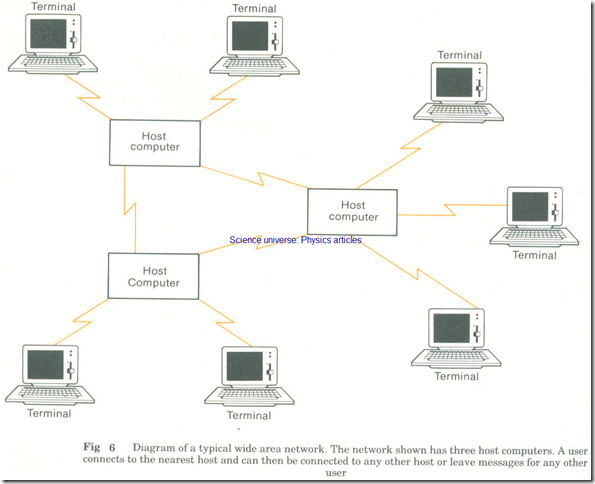Networks
Network is a general term for any set of interconnected points. The meaning used here refers to a computer network.
A network is a system of computers and workstations connected together. There are two main types of networks, local area networks and wide area networks.
Networks are becoming increasingly important because they allow processing to be distributed. A distributed processing system is one where processing is not concentrated at one place. Users or small installations can work independently of the main system but can link up to the network when they want to.
LOCAL AREA NETWORKS
A local area network (or LAN) is a network which is all on one site, such as a school or a block of offices.
Characteristics of local area networks
1 The workstations are usually microcomputers.
Fig 5 Diagram of a typical local area network. In this example there is only one file server, which also serves the only printer. More printers, disc units, file servers and work stations can be added
2 The communication between workstations is usually along cables.
3 The network usually contains peripherals such as hard-disc units and printers to which all users have access via the network.
4 There is no central powerful computer (see multi-access systems . The workstations can operate on their own, without the network. However, there may be one or more stations dedicated to controlling the work of the main disc unites) and printer(s).
A file server is a computer on a network dedicated to handling users’ files.
A local network may be arranged in various ways. Fig 5 shows the type of network common in schools. The stations are all connected to one cable. Each end of the cable has a terminator. The example shown has one computer controlling both the printer and the hard-disc unit Other networks may not have this arrangement
Examples of local area networks
1 In a school (see Fig 5). The stations are microcomputers and the network has a dotmatrix printer and a hard-disc unit. Most of the computers are in one room but the file server is in a separate office. There is also one workstation at the front of a classroom with a large screen so that the teacher can show it to a whole class. The network is used by Computer Studies pupils to do coursework and also by classes in other subjects.
2 In the Business Studies department of a college. The workstations are microcomputers used mainly for word-processing. The network has a laser printer which can produce high-quality printing of letters. A hard-disc unit is used mainly for storing files of text.
3 In a small company which sells, services and repairs cars. Each office has a workstation and so do the stores, the salesroom and the service area. The system is used mainly to deal with:
(a) Communication between management and secretaries dealing with correspondence.
(b) Stock control for parts in the stores.
(c) Sales of cars.
For example, the stations in the stores and service areas are usually running a stock control program. However, they can, if necessary, interrupt this and send messages to sales or office staff.
Advantages and disadvantages of local area networks
Advantages
1 The workstations are usually separate computers. If the network breaks down, they can each still be used on their own.
2 The stations can share peripherals. Disc units and printers can be of better quality because they do not have to be bought for each station.
3 Users do not need to have separate discs. They can sit down at any of the work stations and access their own tiles from the file server.
4 A number of stations can all access and run the same program.
5 The stations can communicate with one another.
Disadvantages
1 If the file server for a network breaks down, the users will have no files to work with. However, they may still be able to use the stations as separate computers.
2 If only a small number of stations is required, then a network is expensive. The file server is usually more expensive than an ordinary station. It is also usually dedicated to the network and cannot be used for anything else while the network is running.
WIDE AREA NETWORKS
A wide area network (or WAN) is a network which connects large numbers of computers and terminals over long distances. (See Fig 6.)
Characteristics of wide area networks
1 The workstations are terminals or microcomputers.
2 The network is usually nationwide or even worldwide.
3 Computing power for the network may be provided by a number of mainframe computers. These may be remote from one another, connected by high-speed data links.
4 Users will usually be able to connect to a point on the network near to them. For example a user connected by telephone will often be able to make a local call.
Fig 6 Diagram of a typical wide area network. The network shown has three host computers. A user connects to the nearest host and can then be connected to any other host or leave messages for any other user .
Examples of wide area networks
1 A large international company has mainframe computers in a number of countries. These are networked together so that employees in all the countries can:
(a) Communicate with one another by electronic mail .
(b) Keep a personal diary on the network so that other people can easily arrange meetings with them.
(c) Use a noticeboard facility to find out about research, courses, and so on in the other countries.
(d) Use software and databases available anywhere in the company.
2 A public Viewdata network. In Britain (and other countries) there are a number of networks available to the public. They are usually accessed using the telephone system. The user needs a terminal and a modem and has to pay a subscription. Examples are PRESTEL and The Times Network for Schools-for details.
Advantages and disadvantages of wide area networks
Advantages and disadvantages of viewdata networks are dealt
Advantages
1 The user has a fast means of communication with other users wherever they are.
2 Access is provided to large databases and other mainframe facilities.
Disadvantage
You can only communicate with someone over the network if they are a member and if they use it regularly.


